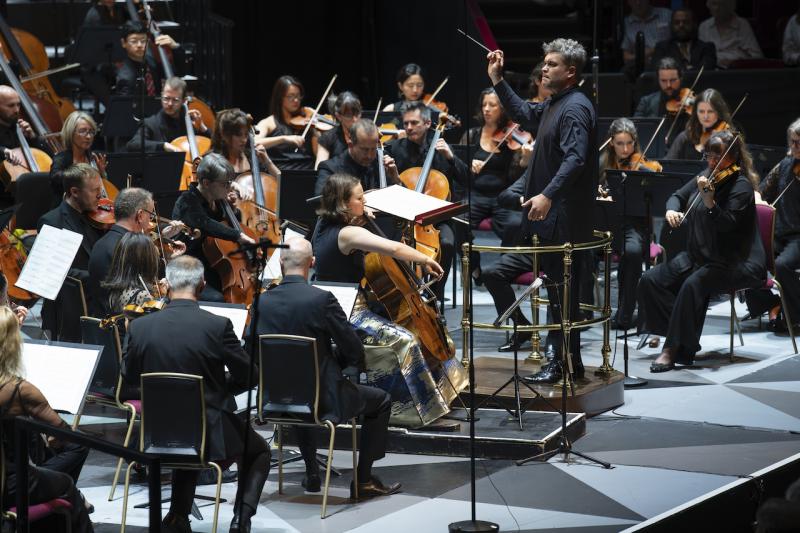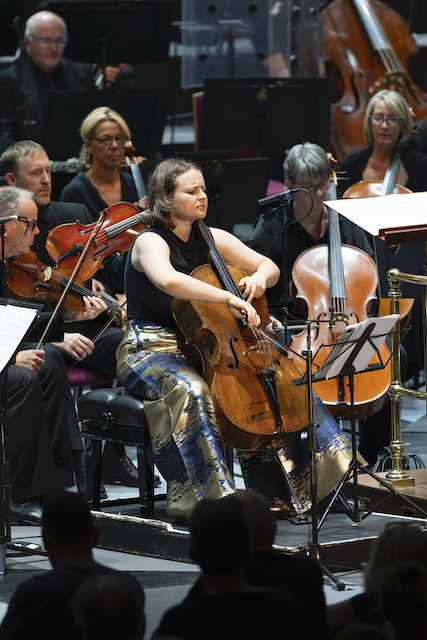Prom 10, Van der Heijden, BBCSSO, Ryan Wigglesworth review - an engaging and esoteric delight | reviews, news & interviews
Prom 10, Van der Heijden, BBCSSO, Ryan Wigglesworth review - an engaging and esoteric delight
Prom 10, Van der Heijden, BBCSSO, Ryan Wigglesworth review - an engaging and esoteric delight
Celebrating 'all things English' with the BBC Scottish Symphony Orchestra

What is Englishness? Over the last century the answer has changed substantially. Yet last night’s Prom, which – according to the programme – set itself the task of celebrating “all things English” had a very particular answer.
This was an England of Eric Ravilious paintings, Earl Grey tea, the vibrant greens of a hedgerow, the gentle plop of croquet mallets against croquet balls. The compositions spanned more than a century, and their reference points more than half a millennium, yet they all had an elegance and subtlety that evoked a very homegrown pastoral tradition.
From the outset, conductor Ryan Wigglesworth guided the BBC Scottish Symphony Orchestra to create an exquisite tapestry of sound, shifting delicately between the different rhythmic motifs and harmonic colours. For the two more established composers of the evening – Britten and Elgar – he picked pieces that had initially faced a chilly reception from critics, deftly revealing their understated delights and complex emotional palettes.
The Symphonic Suite from Gloriana(1953) was created from the opera about Elizabeth I that he composed to celebrate the coronation of Elizabeth II, latterly described by one publication as one of the “great disasters of operatic history”. It opens, as the opera does, with "The Tournament", a vision of pageantry crisply evoked by the orchestra, with its gleaming brass opening quickly succeeded by the disciplined rattle of percussion and subtle flurries of strings.
Even for naysayers, the "Lute Song" that followed – in which the oboe takes on the voice of the Earl of Essex from the original opera – ia filled with exquisite emotion and diaphanous textures. Stella McCracken's solo was captivating, impacting on the sustained harmonies like a pebble sending ripples across a lake in evening sunlight. The "Courtly Dances" – notably selected by Sir Paul McCartney as his only classical choice for Desert Island Discs in 1982 – were as stylish as they were buoyant, not least in the Pavane, in which solemn harmonies underpinned the sumptuous, velvety brass. The Morris Dancing, with its glissandi on the trombones, managed to be gently comic while evading naffness, and the Lavolta at the end ravishingly wrapped up the suite’s musical themes as it sped us to its spellbinding finish on the lone double bass.
 For much of his career, Britten had defined himself in opposition to composers of the English Pastoral School who took their cue from Tudor works. So while this interpretation of his symphonic suite was as illuminating as it was convincing, it was simultaneously a demonstration of Britten at his least Brittenish.
For much of his career, Britten had defined himself in opposition to composers of the English Pastoral School who took their cue from Tudor works. So while this interpretation of his symphonic suite was as illuminating as it was convincing, it was simultaneously a demonstration of Britten at his least Brittenish.
Ironically it was Cheryl Frances-Hoad’s new cello concerto, Earth, Sea, Air – premiered in Glasgow in 2022 – that marked itself out as the true heir to Britten here, with its agile atonal restlessness. Cellist Laura van der Heijden (pictured left) – for whom it was composed – delivered the concerto with her characteristic flair and intellectual rigour, evoking the flight of a swift across a turbulent world.
In the second movement, in which the swift flies over the sea, what was most striking was the sense of different levels of the ocean, ranging from the more sunlit zones at the top to the pitch black “hadal” zones at the very bottom. At one of the most striking moments Van der Heijden performed a hypnotic duet with the glockenspiel, the latter creating a translucent counterpoint to the cello’s streaks of colour, before crescendoing trombones and strings brought a sense of waves and coming to the surface.
The final movement, inspired by nature writer Robert Macfarlane’s observation that the “air must be honeycombed, with transparent tubes down which the swifts were sliding”, swept us through the bird’s immediate surroundings as it shimmered and popped with subtle textures. Following this virtuoso display, Van der Heijden played an arrangement of the traditional Song of the Birds – arranged by Casals among others – which was received with rapturous applause. There has been a significant revision of the public response to Elgar’s Second Symphony since the first performance in which Elgar observed sourly that the audience “sat there like a lot of stuffed pigs”. Now its emotional ambiguity and harmonic experimentalism mark it out as one of his more respected works.
There has been a significant revision of the public response to Elgar’s Second Symphony since the first performance in which Elgar observed sourly that the audience “sat there like a lot of stuffed pigs”. Now its emotional ambiguity and harmonic experimentalism mark it out as one of his more respected works.
The opening "Spirit of Delight" theme heralded an eruption of mirth before the mood became more lyrical and speculative. Wigglesworth superbly guided the orchestra so that the shifts in tone were seamless. Though there were clear echoes of other Elgar works here – not least the Pomp and Circumstance marches in the magnificent descending brass passages – the 12/8 time signature created a sense of fluidity and freedom that distinguished it from the formality of his more famous compositions.
This, in many ways, felt like Elgar with the skin removed so we could see the electrical signals darting through his nervous system. Though the second movement took us into a 4/4 time signature, the overall sense was of elegiac shimmering light, the warm colours heightened by the yearning brass and grief-stricken melodies on the violins. Helter-skeltering strings and woodwind swept us through the pastoral third movement with its increasingly sinister tones, before the Moderato e maestoso brought the symphony to its reflective, intimate conclusion.
The hall was not as crammed as it has been for more obvious crowd-pleasers – like Verdi’s Requiem earlier this week – yet this was an engaging and esoteric delight. Performed on the same night as the Paris Olympics opening ceremony, the programme’s highlighting of the connection between Frances-Hoad and Britten especially was one of many demonstrations of how Proms programming at its best hands the torch from generation to generation.
rating
Explore topics
Share this article
The future of Arts Journalism
You can stop theartsdesk.com closing!
We urgently need financing to survive. Our fundraising drive has thus far raised £49,000 but we need to reach £100,000 or we will be forced to close. Please contribute here: https://gofund.me/c3f6033d
And if you can forward this information to anyone who might assist, we’d be grateful.

Subscribe to theartsdesk.com
Thank you for continuing to read our work on theartsdesk.com. For unlimited access to every article in its entirety, including our archive of more than 15,000 pieces, we're asking for £5 per month or £40 per year. We feel it's a very good deal, and hope you do too.
To take a subscription now simply click here.
And if you're looking for that extra gift for a friend or family member, why not treat them to a theartsdesk.com gift subscription?
more Classical music
 Bizet in 150th anniversary year: rich and rare French offerings from Palazzetto Bru Zane
Specialists in French romantic music unveil a treasure trove both live and on disc
Bizet in 150th anniversary year: rich and rare French offerings from Palazzetto Bru Zane
Specialists in French romantic music unveil a treasure trove both live and on disc
 Scottish Chamber Orchestra, Ibragimova, Queen’s Hall, Edinburgh review - rarities, novelties and drumrolls
A pity the SCO didn't pick a better showcase for a shining guest artist
Scottish Chamber Orchestra, Ibragimova, Queen’s Hall, Edinburgh review - rarities, novelties and drumrolls
A pity the SCO didn't pick a better showcase for a shining guest artist
 Kilsby, Parkes, Sinfonia of London, Wilson, Barbican review - string things zing and sing in expert hands
British masterpieces for strings plus other-worldly tenor and horn - and a muscular rarity
Kilsby, Parkes, Sinfonia of London, Wilson, Barbican review - string things zing and sing in expert hands
British masterpieces for strings plus other-worldly tenor and horn - and a muscular rarity
 From Historical to Hip-Hop, Classically Black Music Festival, Kings Place review - a cluster of impressive stars for the future
From quasi-Mozartian elegance to the gritty humour of a kitchen inspection
From Historical to Hip-Hop, Classically Black Music Festival, Kings Place review - a cluster of impressive stars for the future
From quasi-Mozartian elegance to the gritty humour of a kitchen inspection
 Shibe, LSO, Adès, Barbican review - gaudy and glorious new music alongside serene Sibelius
Adès’s passion makes persuasive case for the music he loves, both new and old
Shibe, LSO, Adès, Barbican review - gaudy and glorious new music alongside serene Sibelius
Adès’s passion makes persuasive case for the music he loves, both new and old
 Anja Mittermüller, Richard Fu, Wigmore Hall review - a glorious hall debut
The Austrian mezzo shines - at the age of 22
Anja Mittermüller, Richard Fu, Wigmore Hall review - a glorious hall debut
The Austrian mezzo shines - at the age of 22
 First Person: clarinettist Oliver Pashley on the new horizons of The Hermes Experiment's latest album
Compositions by members of this unusual quartet feature for the first time
First Person: clarinettist Oliver Pashley on the new horizons of The Hermes Experiment's latest album
Compositions by members of this unusual quartet feature for the first time
 Gesualdo Passione, Les Arts Florissants, Amala Dior Company, Barbican review - inspired collaboration excavates the music's humanity
At times it was like watching an anarchic religious procession
Gesualdo Passione, Les Arts Florissants, Amala Dior Company, Barbican review - inspired collaboration excavates the music's humanity
At times it was like watching an anarchic religious procession
 Classical CDs: Camels, concrete and cabaret
An influential American composer's 90th birthday box, plus British piano concertos and a father-and-son duo
Classical CDs: Camels, concrete and cabaret
An influential American composer's 90th birthday box, plus British piano concertos and a father-and-son duo
 Cockerham, Manchester Camerata, Sheen, Martin Harris Centre, Manchester review - re-enacting the dawn of modernism
Two UK premieres added to three miniatures from a seminal event of January 1914
Cockerham, Manchester Camerata, Sheen, Martin Harris Centre, Manchester review - re-enacting the dawn of modernism
Two UK premieres added to three miniatures from a seminal event of January 1914
 Kempf, Brno Philharmonic, Davies, Bridgewater Hall, Manchester review - European tradition meets American jazz
Bouncing Czechs enjoy their Gershwin and Brubeck alongside Janáček and Dvořák
Kempf, Brno Philharmonic, Davies, Bridgewater Hall, Manchester review - European tradition meets American jazz
Bouncing Czechs enjoy their Gershwin and Brubeck alongside Janáček and Dvořák
 Solomon, OAE, Butt, QEH review - daft Biblical whitewashing with great choruses
Even a top soprano and mezzo can’t make this Handel paean wholly convincing
Solomon, OAE, Butt, QEH review - daft Biblical whitewashing with great choruses
Even a top soprano and mezzo can’t make this Handel paean wholly convincing

Add comment